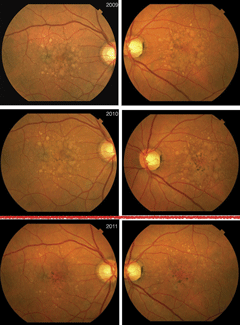Statin Treatment Aids in AMD Therapy
A common cholesterol-lowering drug holds promise for some patients with dry age-related macular degeneration.By Rebecca Hepp, Senior Associate Editor
 |
| Click image to enlarge. Color fundus images of a 63-year-old man with AMD and large soft drusen and drusneoid pigment epithelial detachments. Upper panel is at presentation, middle panel shows one year later at start of atorvastatin and lower panel shows a year after treatment. Photo: Vavvas DG, Daniels AB, Kapsala ZG, et al. |
Researchers from the Massachusetts Eye and Ear/Harvard Medical School and the University of Crete have discovered that high doses of statins led to the regression of soft lipid deposits for some patients with dry age-related macular degeneration (AMD).
“This is a very interesting study,” says Steven Ferrucci, OD, of the US Department of Veterans Affairs in North Hills, Calif., and professor at the Southern California College of Optometry at Marshall B. Ketchum University in Los Angeles. “For many years, researchers have postulated that stains may be protective in AMD, as AMD and cardiovascular disease share many of the same risk factors.”
The study, recently published in EBioMedicine, looked at 23 patients with dry AMD who had soft lipid deposits in the outer retina. The participants were prescribed 80mg of Lipitor (atorvastatin, Pfizer), a drug FDA-approved to help lower cholesterol, and were monitored every three months with a complete ophthalmologic exam. After a minimum of one year, 10 of the 23 patients experienced an elimination of the deposits under the retina and mild improvement in visual acuity, and none progressed to advanced neovascular AMD.
“Repurposing current FDA-approved medications such as statins that are very accessible would be huge, as well as represent a huge cost and time saving over discovering a novel drug,” says Dr. Ferrucci. “These drugs are already well studied, with a good safety profile and lots of clinical experience regarding dosing and side effects.”
While the results are promising, more research is needed to address the study’s limitations and advance the understanding of the possible new treatment option.
“It should be realized that this is a very small study, with only 23 patients,” Dr. Ferrucci says. “More research with a larger study must be done, and even then it seems it may only benefit a percentage of AMD patients [those with soft lipid deposits] and may not help with geographic atrophy or those with pigmentary changes, or hard and reticular drusen.”
“Clinically, we should stay alert of such studies to properly inform our patients of new developments that may be of help, as well as temper those stories that might send false hope,” says Dr. Ferrucci. “Due to the increasing aging population, finding safe and inexpensive strategies for the treatment or management of AMD is paramount.”
|
Vavvas DG, Daniels AB, Kapsala ZG, et al. Regression of some high-risk features of age-related macular degeneration (AMD) in patients receiving intensive statin treatment. EBioMedicine. 2016; DOI: 10.1016/j.ebiom.2016.01.033. |
A Call for Expanded Glaucoma Care
The Department of Justice (DOJ) and the Federal Trade Commission (FTC) recently submitted a joint statement encouraging the Massachusetts legislature to consider expanding optometrists’ scope of practice for glaucoma management. The DOJ and FTC submitted the statement in response to State Representative Bradley H. Jones’ request for views on expanding Massachusetts optometrists’ scope of practice, which could take effect with the passage of House Bill 1973 (HB 1973).
Physics of Pancakes Aids in Glaucoma Surgery |
The statement addresses the potential benefits of enhanced competition among glaucoma care providers, such as greater access to timely and cost-competitive care.
“We note that unnecessarily broad scope of practice restrictions can impose significant competitive costs on health care consumers and other payors,” the DOJ and FTC wrote in the statement. “We write now to highlight the potential competitive costs of a continued prohibition on Massachusetts optometrists’ ability to treat glaucoma and to encourage the legislature to consider the competitive implications of such a restriction in its evaluation of the bill.”
HB 1973 would allow Massachusetts optometrists to treat glaucoma using medications, subject to certain training and referral requirements.
The statement also recommends the legislature maintain only those restrictions on optometrists’ ability to treat glaucoma that are necessary to ensure patient health and safety.Visual Clarity of Highway Signs
The U.S. Federal Highway Administration (FHWA) recently announced that, moving forward, highway signs will use the font Highway Gothic, which dates back nearly 70 years, rather than the alternative Clearview font.The newer font was approved in 2004 in the FHWA’s Interim Approval for Use of Clearview Font for Positive Contrast Legends on Guide Signs and has since been approved by nearly 30 states, according to an article published in CityLab. It was an unfortunate announcement that will have big implications going forward, said Donald Meeker, co-designer of the Clearview font, in the article.
The FHWA originally supported the new font for its apparent superior legibility for nighttime driving; however, the FHWA now states the font has performed contrary to its intended purpose, the article states. The licensing fees may also be behind the switch, the article says.
Paul Harris, OD, of the Souther College of Optometry says that contrast is key and natural wear-and-tear may be to blame for the apparent waning of support for the new font. “It is recommended that vision charts be replaced every seven years,” says Dr. Harris. “As dirt minimizes the contrast between the white color of the font, and the surface gets worn and loses reflectance, the lack in contrast will take its toll on the visibility on the signs.” Dr. Harris also notes highway sign placement as a whole may trump any small font changes, considering the loss of contrast to signs over time.


